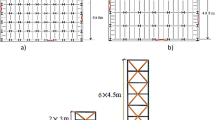Abstract
Buckling restrained knee braced truss moment frame (BRKBTMF) is a novel and innovative steel structural system that utilizes the advantages of long-span trusses and dedicated structural fuses for seismic applications. Steel trusses are very economical and effective in spanning large distance. However, conventional steel trusses are typically not suitable for seismic application, due to its lack of ductility and poor energy dissipation capacity. BRKBTMF utilizes buckling restrained braces (BRBs) as the designated structural fuses to dissipate the sudden surge of earthquake energy. This allows the BRKBTMF to economically and efficiently create large span structural systems for seismic applications. In this paper, a prototype BRKBTMF office building located in Berkeley, California, USA, was designed using performance-based plastic design procedure. The seismic performance of the prototype building was assessed using the state-of-the-art finite element software, OpenSees. Detailed BRB hysteresis and advanced element removal technique was implemented. The modeling approach allows the simulation for the force-deformation response of the BRB and the force redistribution within the system after the BRBs fracture. The developed finite element model was analyzed using incremental dynamic analysis approach to quantify the seismic performance of BRKBTMF. The results show BRKBTMF has excellent seismic performance with well controlled structural responses and resistance against collapse. In addition, life cycle repair cost of BRKBTMF was assessed using the next-generation performance-based earthquake engineering framework. The results confirm that BRKBTMF can effectively control the structural and non-structural component damages and minimize the repair costs of the structure under different ranges of earthquake shaking intensities. This studies conclude that BRKBTMF is a viable and effective seismic force resisting system.
Similar content being viewed by others
References
Wongpakdee N, Leelataviwat S, Goel S C, Liao W C. Performancebased design and collapse evaluation of buckling restrained knee braced truss moment frames. Engineering Structures, 2014, 60: 23–31
Yang T Y, Li Y, Leelataviwat S. Performance-based design and optimization of buckling restrained knee brace truss moment frame. Journal of Performance of Constructed Facilities, 2014, 28(6): A4014007
Yang T Y, Li Y, Goel S. Performance evaluation of long-span conventional moment frames and buckling-restrained knee-braced truss moment frames. Journal of Structural Engineering, 2015, 142 (1): 04015081
Goel S C, Chao S H. Performance-Based Plastic Design: Earthquake- Resistant Steel Structures. International Code Council, USA, 2008
PEER. Open System for Earthquake Engineering Simulation (OpenSees). Pacific Earthquake Engineering Research Center, University of California, Berkeley, CA, 2000
Talaat M, Mosalam K M. Modeling progressive collapse in reinforced concrete buildings using direct element removal. Earthquake Engineering & Structural Dynamics, 2009, 38(5): 609–634
ASCE. Minimum Design Loads for Buildings and Other Structures. SEI/ASCE 7–10. Reston, VA, USA, 2010
UCB. U.C. Berkeley Seismic Guideline. University of California, Berkeley, 2003
Merritt S, Uang C M, Benzoni G. Subassemblage Testing of CoreBrace Buckling Resitrained Brace. Report No. TR-2003/01, University of California, San Diego, CA, USA, 2003
López WA, Sabelli R. Seismic design of buckling-restrained braced frames. Steel tips, 2004
PEER. PEER Strong Motion Database. University of California at Berkeley, 2010 (Retrieved from http://peer.berkeley.edu/peer_- ground_motion_database)
Vamvatsikos D, Cornell C A. Incremental Dynamic Analysis. Earthquake Engineering & Structural Dynamics, 2002, 31(3): 491–514
Yang T Y, Moehle J P, Stojadinovic B. Performance Evaluation of Innovative Steel Braced Frames–PEER Report 2009/103. Pacific Earthquake Engineering Research Center, College of Engineering, University of California, Berkeley, CA, USA, 2009
Yang T Y, Moehle J P, Stojadinovic B, Der Kiureghian A. Seismic performance evaluation of facilities: Methodology and implementation. Journal of Structural Engineering, 2009, 135(10): 1146–1154
Applied Technology Council. Development of next-generation performance-based seismic design procedures for new and existing buildings, 2012 (https://www.atcouncil.org/projects-sp- 1235934887/project-atc58)
Author information
Authors and Affiliations
Corresponding author
Rights and permissions
About this article
Cite this article
Yang, T.T.Y., Li, Y. Performance assessment of innovative seismic resilient steel knee braced frame. Front. Struct. Civ. Eng. 10, 291–302 (2016). https://doi.org/10.1007/s11709-016-0340-3
Received:
Accepted:
Published:
Issue Date:
DOI: https://doi.org/10.1007/s11709-016-0340-3




